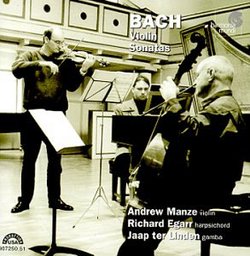Less is often more
Isabella Channel | 03/12/2000
(4 out of 5 stars)
"I am a big fan of Andrew Manze, but I think this is not his best recording nor the best there is of these marvelous sonatas. For a more consistent and musical view go for Fabio Biondi's otstanding reading in OPUS111. He and Rinaldo Alessandrini are warmer and more engaging."
Perplexed I am...
François Beaudoin | Québec ( Ville fortifiée), Canada | 09/07/2006
(1 out of 5 stars)
"I have a challenge for you, loyal listeners of Andrew MANZE : Try to listen to these two CDS in one shot ! If you can't, like me, it is, perhaps, for the following reasons :
First, the recording. We have to put the volume so loud that we
have, of course, a background sound. So the BIG gamba of LINDEN sound like a hammer. First moment of a great irritability. And its only the beginning of a long and painful period of frustations.
What's the problem with the violin of Manze ? Or what is the problem with MANZE himself ? Has he listened to his work after this recording ? HIS VIOLIN is creaking, acid, strident; it becomes rapidly unbearable; and four about two hours ! A pure moment of torture for my ears !
The curious idea to join a gamba to sonatas 1014 and 1015 could have been interesting. But, unfortunately, Manze is so slow, so lazy, so boring with is strident instrument that we want to go elsewere immediately ! For instance , the FAMOUS 1019, first allegro: a complete failure ! Deadly dull! No ZEST, AN INAUDIBLE violin whithout any energy; no excitement there ! And what about the famous preludo of the 1023 ? Manze delivers a dramatic and interminable performance which is, again, extremely boring. Remember its' BAROQUE music. Why this romanticism ?
The rare good moments ? The 1021 is successfully done. The short presto is thrilling. And the 1024 is well executed. That's all...
Where is the exuberance of Goebel/Hill on the Archiv label ? Or the excitement of Valetti/Frisch on the Alpha label ?
"
Dryly professional
Eugene C. Braig IV | Columbus, OH United States | 01/22/2006
(3 out of 5 stars)
"I don't take so vitriolic a view of Manze's CDs as some other reviewers of other discs. I like much of his recorded output: his speculative unaccompanied performances of Tartini are fun-even wholly appropriate for the didactic "l'arte del arco"-and his rather academic approach does work very nicely for Telemann's decidedly un-Italian music.
I very much appreciate the effort to reconstruct earlier versions of BWV 1019. I'm not aware of all the alternative movements being available elsewhere and believe this is this recording's biggest selling point.
The performances of Bach's accompanied violin sonatas are solid and professional, as should be expected of musicians at this level. Personally, I find them to sound a bit more like a profound act of scholarship than enjoyably listenable music. For example, Manze's relatively straight phrasing and somber tempo in the opening movement of BWV 1023 is nicely played, but conveys precious little of the potential musicality. Even though the movement is made up of rather straightforward arpeggios, compare the approach of Reinhard Goebel, e.g (1985. Archiv, 427 152-2). Goebel's impassioned playing and phrasing of the arpeggio figures is musical and expressive...and exciting...in a way that transcends skilled execution of simple arpeggios from the printed page.
Peter Williams' (1981) speculation that the Toccata & Fugue, BWV 565, may have been conceived as a violin solo has received a great deal of recent attention. Citing Jaap Schroeder (1985) as inspiration, the speculative reconstruction of BWV 565 is where this recording really lost me. Both the Toccata and coda material are very effective, very enjoyable, and cleverly transcribed in using rapid arpeggios and double stops to outline the huge chords from the semi-dubious organ scores that have come down to us. Unfortunately, I found the whole stretch of the fugue between to be dry and monotonous. Ironically, where double stops would be most useful in sketching polyphony is the very place where double stops are wholly absent. As Manze clearly states, the texture in his transcription of the body of the fugue is very strictly monophonic:
"...the Fugue indulges in the conceit of sounding polyphonic, literally `many voiced,' without once employing any double stopping. Instead, the impression of polyphony is given by a careful handling of voice leading and tessitura, rather than a bewildering succession of unidiomatically virtuosic, cat's-cradle chords."
As hard as I tried, I could not find much feeling of implied polyphony in the body of the fugue. In spite of occasional modulation, it comes off as a tediously endless repetition of the pedal-point-rich fugue theme.
The most cursory listen to the fugues Bach did write for unaccompanied violin (of course, from BWV 1001, 1003, and 1005: see Milstein on Deutsche Grammophon, e.g.) reveals that this strict monophonic approach to implied polyphony was not Bach's typical approach to fugal writing for violin. Obviously, these fugues can't feature 6-note chords extending below the bass clef, but they still are remarkably successful at implying polyphony through frequent double stops and chords that are slightly arpeggiated to conclude on the lead voice. Even pedal passages in the violin fugues often contrast the pedal-point to passages in double stops. In spite of all the well-intended scholarship striving to reconstruct a viable violin version of BWV 565, I think I'll stick to listening to it on the organ.
"


 Track Listings (20) - Disc #1
Track Listings (20) - Disc #1